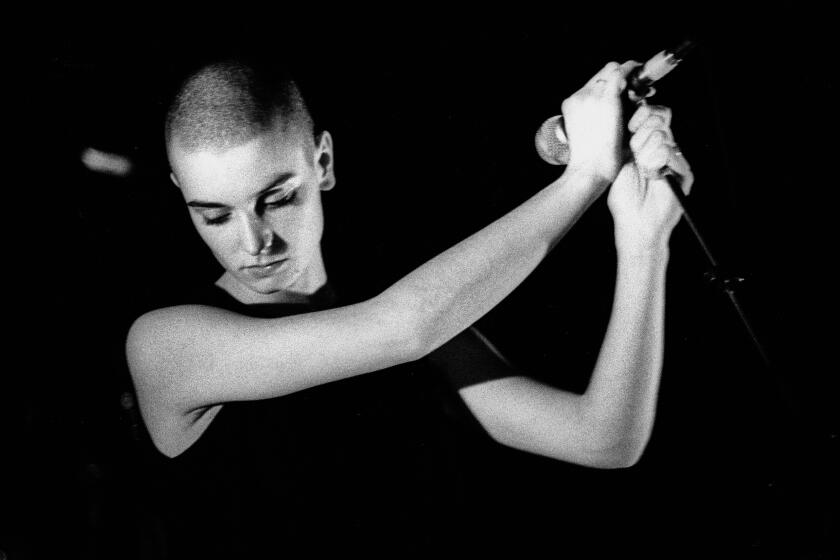10 essential Sinéad O’Connor songs

- Share via
A singer-songwriter of uncommon ferocity and tenderness, Sinéad O’Connor may have been fated to have a short-lived career as a pop star. Her disposition was too mercurial and too empathetic to survive the sustained glare of the spotlight that came her way once her version of Prince’s “Nothing Compares 2 U” became an international blockbuster in 1990.
O’Connor detonated that stardom when she tore a picture of Pope John Paul II at the conclusion of a 1992 performance on “Saturday Night Live,” a gesture that effectively let her return to the alternative-rock subculture from which she emerged in the late 1980s.
Sinead O’Connor, the haunting singer who shot to fame in the ‘90s and sparked controversy with an anti-Catholic protest on live TV in the U.S., has died at 56.
O’Connor, whose death at age 56 was announced today, may have retreated from fame but she never stopped making music, issuing seven albums between “Universal Mother,” the first to appear in the wake of the “SNL” controversy, and “I’m Not Bossy, I’m the Boss,” the last she released in her lifetime. Those albums were often bold stylistic excursions, from the Irish folk of “Sean-Nos Nua” to the reggae “Throw Down Your Arms,” as well as continuations of musical and spiritual ideas she explored at the start of her career on the alt-rock landmarks “The Lion and the Cobra” and “I Do Not Want What I Haven’t Got.”
Listening again to her pivotal early tracks alongside underappreciated singles and deep cuts draws a portrait of a fearless artist whose passion is evident even in her quietest moments.
1. “Troy” (1987)

“Troy” is an unusually audacious debut single, a glowering slow burn in which O’Connor comes to terms with the trauma she endured from her deceased mother by riffing on a William Butler Yeats poem. Containing no overt melodic hooks or conventional pop signifiers, “Troy” is assured in its narrative and skilled in its execution, the conflicts and betrayals steadily amassing as an orchestra acts as both support and a catalyst for her unflinching performance. When she reaches her conclusion — “You’re a liar” — the effect is devastating.
2. “Mandinka” (1987)

Nearly playing as a retort to the dramatic intensity of “Troy,” her second single opens with a barrage of power chords that would not sound out of place in the hands of Keith Richards. The big riff sets the stage for a forceful rocker, but it’s also a bit of a feint: O’Connor is harnessing the conventional pleasures of classic rock to power a celebration of resilience and empowerment.
3. “I Want Your (Hands on Me)” (1988)

O’Connor’s music burns so brightly in its intensity that the playfulness of “I Want Your (Hands on Me)” remains startling. Setting the song to a bright, bustling drum loop, O’Connor sings over a hip-hop beat, her longing serving as a tantalizing contrast to the colorful rhythms. O’Connor never attempted this kind of hybrid again, which is part of the reason that “I Want Your (Hands on Me)” remains compelling on its own terms: It hints at roads she may have taken.
A new documentary, ‘Nothing Compares,’ reconsiders the Irish singer’s legacy 30 years after she blew up her career on ‘SNL’
4. “Nothing Compares 2 U” (1990)

O’Connor plucked this Prince song from an album by his busman’s holiday the Family — the Purple One didn’t even deign to release it on his own — and turned it into an uncommonly somber torch song. She delivers “Nothing Compares 2 U” with all the gravity of a woman who has just lost her love in a fatal accident, milking melodrama out of every lovelorn moment. It’s a performance that illustrates O’Connor’s remarkable facility as a vocalist: alternating between rage and sorrow, her singing has a wounded quality the lyrics lack. In her hands, this throwaway becomes an enduring pop classic.
5. “The Emperor’s New Clothes” (1990)

O’Connor had the ability to make any song, even one she didn’t write, seem like it came from the depths of her soul. “The Emperor’s New Clothes” is filled with imagery that explicitly references her newly found fame and motherhood, life-changing events that caused a riff in her relationships, leading her to conclude: “How could I possibly know what I want / When I was only 21?”
6. “The Last Day of Our Acquaintance” (1990)

As shattering a breakup song as has ever been written, “The Last Day of Our Acquaintance” chronicles not the fracturing of a relationship but the moment it’s grown cold: there’s no anger, only resigned sadness. Fittingly, most of the song is delivered at a volume so hushed, it seems as if O’Connor is whispering more than singing. The stillness is eventually broken by a crescendo that doesn’t quite feel cathartic; the sadness is too deep to shake so quickly.
Before Britney, Demi or even the Dixie Chicks, Sinéad O’Connor said what she thought, did what she wanted and refused to be shut down.
7. “Fire on Babylon” (1994)

O’Connor returned with a whisper, not a scream, when she re-emerged from self-imposed exile after the “Saturday Night Live” controversy. Built on a roiling trip-hop beat and colored by a Miles Davis sample, “Fire on Babylon” is distinguished by her controlled, simmering anger as she examines her tortured relationship with her dead mother — the same subject she explored on “Troy.” Unlike many O’Connor songs, “Fire on Babylon” doesn’t build to a moment of catharsis: the steady rhythms keep rolling, leaving her stuck in a moment, pleading for the deliverance of change.
8. “No Man’s Woman” (2000)

O’Connor’s last attempt at a mainstream single, “No Man’s Woman” bears the markings of its time. With its tasteful trip-hop underpinning and lush swaths of strings, it’s self-consciously classy, a milieu that doesn’t quite suit her. “No Man’s Woman” does, however, suggest what an alternate version of O’Connor, one who played by music-industry conventions, might have sounded like: A singer who credibly competed with the radio-ready, adult-alternative pop of Sheryl Crow or the Cranberries.
9. “The Wolf is Getting Married” (2012)

After spending over a decade wandering through the byways of folk and world music, O’Connor mounted a pop comeback in 2012 with “How About I Be Me (And You Be You?).” The first single from the album, “The Wolf Is Getting Married,” finds her playing flinty, guitar-driven rock for the first time since the early 1990s. There’s an ease and confidence here that comes as a bit of a welcome relief, the sound of a singer-songwriter finding her footing again.
10. “The Voice of My Doctor” (2014)

On “The Voice of My Doctor,” O’Connor delves into previously unexplored territory, grinding out a circular blues riff while exploring psychosexual dynamics of infidelity. From one angle, it sounds like her answer to PJ Harvey; the heavy, heated rock sound invigorates O’Connor, freeing her to deliver a clever and impassioned bit of theater.
More to Read
The biggest entertainment stories
Get our big stories about Hollywood, film, television, music, arts, culture and more right in your inbox as soon as they publish.
You may occasionally receive promotional content from the Los Angeles Times.











